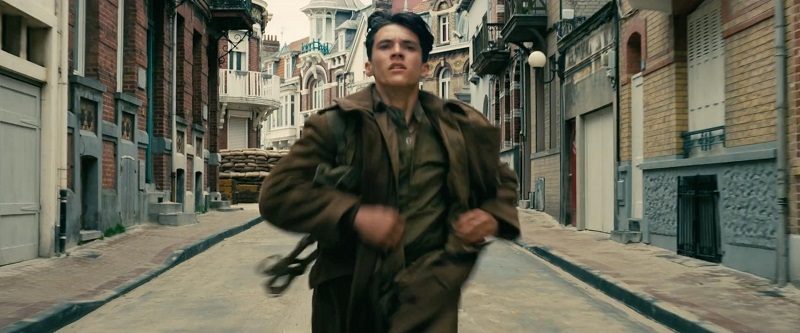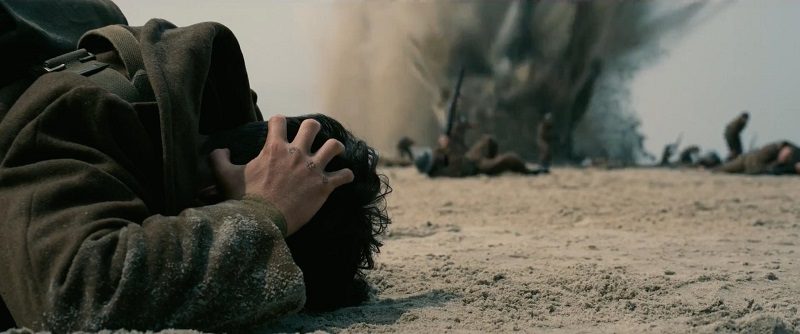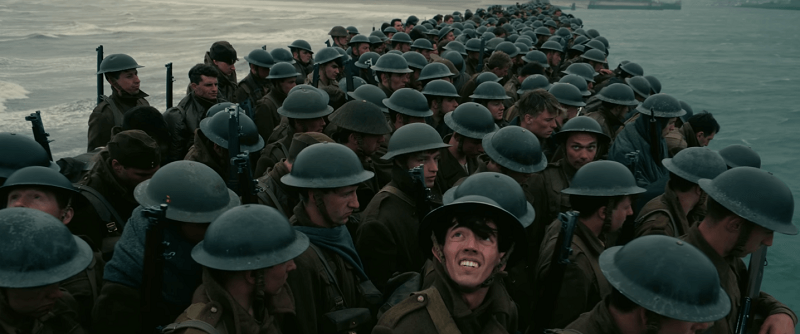Dunkirk Review
"Mermorizing"
After making many psychological and mind bending films the celebrated director Christopher Nolan has moved into making a film about a real historical event and a long awaited passion project for
the filmmaker.
Dunkirk is split into three stories about the evacuation of the British army from Europe during the summer of 1940. The Mole follows a young British soldier (Finn Whitehead) who desperately seeks to get on a boat back home to England; The Sea where a father and son (Mark Rylance and Tom Glynn-Carney) sail their small boat to Dunkirk and save as many soldiers as possible; and The Air which focuses on three Spitfire pilots patrolling the skies over the English Channel.
 Dunkirk
Dunkirk was a film made because of the force and star power of its director. It is a film starring mostly young and unknown actors - it
told a non-traditional war story told in a non-traditional way and a much more subdued story even by Nolan's standards. Its storytelling approach was more in line with Nolan's second film
Memento - a film that told a story in reverse.
From a man who is known for making complex and mind-bending films,
Dunkirk is more straight forward. It is set over a few days and basically is a story of surviving and fighting. Although the premise is simple, Nolan is adventurous with the plot structure: the three stories are told over different periods of time: The Mole takes place over a few days, The Sea is set over one day and the pilots in The Air fly for a few hours. Events that are seen by the pilots are shown from a different point-of-view later in the film. The stories slowly converge and Nolan’s longtime editor Lee Smith deserves recognition for how brings them all together.
 Dunkirk
Dunkirk has been marketed as a blockbuster but it is really a more artistic film that just happened to have a large budget. The story and dialogue is minimalistic - particularly actions on the beach because the characters hardly speak to each other whilst the pilots are speaking like professionals. Their names are hardly uttered. The closest the film gets to a traditional narrative is on the boat – it’s a father-and-son tale: men that are too young or too old to fight but want to do their bit to save as many lives as possible. Rylance, who is has become more recognizable in recent years is the most identifiable character in the film because the audience gets to know more about his past and what drives him to go to Dunkirk. However, this minimalistic approach may put off some audience members because of the backstories of most of the characters are not shown or discussed.
In recent years the war genre has become synonymous with gruesome violence to show the horrors of war -
Saving Private Ryan and
Hacksaw Ridge are great examples of this.
Dunkirk had a PG-13 rating so the film focused on the tension and fear when the soldiers are on the ground instead of fighting. Guns and bombs have an impact just from sounds they make and there is fear on the soldiers' faces when they hear the Luftwaffe approaching. That is how
Dunkirk shows the horrors of war.

Nolan's sense of realism comes from the emotions the characters felt. The troops on the beach are divided, they are at each other's throats and distrusted each other. Troops are only loyal to their own units and regiments. The Dunkirk spirit came from the civilians who set out to save as many soldiers as possible - saving over 300,000 of the 400,000 soldiers trapped on the beaches. Nolan was able to show the event as it has often been described - a miracle and turned an impending military disaster into a triumph. It matched the mood of the time.
Dunkirk has already been touted as an Oscar contender and it is properly Nolan's best shot for awards recognition.
Dunkirk has a solid chance to get a Best Picture and Best Director nomination and it deserves to be considered for its technical achievements - i.e. editing, sound, special effects, cinematography and music.
The cast was mostly made up of young unknowns. Nolan's aim was to be authentic as possible because most of the soldiers fighting at Dunkirk were men in their 20s and they gave understated natural performances. Actors like Fionn Whitehead, Jack Lowden, Tom Glynn-Carney and Barry Keoghan should have solid careers ahead of them. One Direction fans should be pleased that Harry Styles also gave a solid performance and even the boy band's most verbal detractors can't criticize Styles for starting his acting career in such a prestigious film.

Actors like Tom Hardy, Cillian Murphy, Kenneth Branagh and the already mentioned Rylance gave
Dunkirk an extra sense of gravitas in their supporting roles. Rylance and Murphy had the juicer roles because they had past traumas whilst Branagh was a commander hoping for a miracle. Hardy's role could have been played by anyone and he properly took it because of his previous working relationship with Nolan.
Nolan fans will be pleased with his war effort and
Dunkirk makes for an interesting alternative to more action-orientated films in the war genre. It is more a subdue art-piece that was able to find a major audience because of its big name director.
Dunkirk is more like
Ivan's Childhood than
Saving Private Ryan.
Pros
- Ambitious for a big budget film
- The minimalistic approach to dialogue and characters
- The sense of fear and tension
- The three stories act as a microcosm of the wider war situation
Cons
- The lack of dialogue may turn off some viewers
 Dunkirk was a film made because of the force and star power of its director. It is a film starring mostly young and unknown actors - it told a non-traditional war story told in a non-traditional way and a much more subdued story even by Nolan's standards. Its storytelling approach was more in line with Nolan's second film Memento - a film that told a story in reverse.
From a man who is known for making complex and mind-bending films, Dunkirk is more straight forward. It is set over a few days and basically is a story of surviving and fighting. Although the premise is simple, Nolan is adventurous with the plot structure: the three stories are told over different periods of time: The Mole takes place over a few days, The Sea is set over one day and the pilots in The Air fly for a few hours. Events that are seen by the pilots are shown from a different point-of-view later in the film. The stories slowly converge and Nolan’s longtime editor Lee Smith deserves recognition for how brings them all together.
Dunkirk was a film made because of the force and star power of its director. It is a film starring mostly young and unknown actors - it told a non-traditional war story told in a non-traditional way and a much more subdued story even by Nolan's standards. Its storytelling approach was more in line with Nolan's second film Memento - a film that told a story in reverse.
From a man who is known for making complex and mind-bending films, Dunkirk is more straight forward. It is set over a few days and basically is a story of surviving and fighting. Although the premise is simple, Nolan is adventurous with the plot structure: the three stories are told over different periods of time: The Mole takes place over a few days, The Sea is set over one day and the pilots in The Air fly for a few hours. Events that are seen by the pilots are shown from a different point-of-view later in the film. The stories slowly converge and Nolan’s longtime editor Lee Smith deserves recognition for how brings them all together.
 Dunkirk has been marketed as a blockbuster but it is really a more artistic film that just happened to have a large budget. The story and dialogue is minimalistic - particularly actions on the beach because the characters hardly speak to each other whilst the pilots are speaking like professionals. Their names are hardly uttered. The closest the film gets to a traditional narrative is on the boat – it’s a father-and-son tale: men that are too young or too old to fight but want to do their bit to save as many lives as possible. Rylance, who is has become more recognizable in recent years is the most identifiable character in the film because the audience gets to know more about his past and what drives him to go to Dunkirk. However, this minimalistic approach may put off some audience members because of the backstories of most of the characters are not shown or discussed.
In recent years the war genre has become synonymous with gruesome violence to show the horrors of war - Saving Private Ryan and Hacksaw Ridge are great examples of this. Dunkirk had a PG-13 rating so the film focused on the tension and fear when the soldiers are on the ground instead of fighting. Guns and bombs have an impact just from sounds they make and there is fear on the soldiers' faces when they hear the Luftwaffe approaching. That is how Dunkirk shows the horrors of war.
Dunkirk has been marketed as a blockbuster but it is really a more artistic film that just happened to have a large budget. The story and dialogue is minimalistic - particularly actions on the beach because the characters hardly speak to each other whilst the pilots are speaking like professionals. Their names are hardly uttered. The closest the film gets to a traditional narrative is on the boat – it’s a father-and-son tale: men that are too young or too old to fight but want to do their bit to save as many lives as possible. Rylance, who is has become more recognizable in recent years is the most identifiable character in the film because the audience gets to know more about his past and what drives him to go to Dunkirk. However, this minimalistic approach may put off some audience members because of the backstories of most of the characters are not shown or discussed.
In recent years the war genre has become synonymous with gruesome violence to show the horrors of war - Saving Private Ryan and Hacksaw Ridge are great examples of this. Dunkirk had a PG-13 rating so the film focused on the tension and fear when the soldiers are on the ground instead of fighting. Guns and bombs have an impact just from sounds they make and there is fear on the soldiers' faces when they hear the Luftwaffe approaching. That is how Dunkirk shows the horrors of war.
 Nolan's sense of realism comes from the emotions the characters felt. The troops on the beach are divided, they are at each other's throats and distrusted each other. Troops are only loyal to their own units and regiments. The Dunkirk spirit came from the civilians who set out to save as many soldiers as possible - saving over 300,000 of the 400,000 soldiers trapped on the beaches. Nolan was able to show the event as it has often been described - a miracle and turned an impending military disaster into a triumph. It matched the mood of the time.
Dunkirk has already been touted as an Oscar contender and it is properly Nolan's best shot for awards recognition. Dunkirk has a solid chance to get a Best Picture and Best Director nomination and it deserves to be considered for its technical achievements - i.e. editing, sound, special effects, cinematography and music.
The cast was mostly made up of young unknowns. Nolan's aim was to be authentic as possible because most of the soldiers fighting at Dunkirk were men in their 20s and they gave understated natural performances. Actors like Fionn Whitehead, Jack Lowden, Tom Glynn-Carney and Barry Keoghan should have solid careers ahead of them. One Direction fans should be pleased that Harry Styles also gave a solid performance and even the boy band's most verbal detractors can't criticize Styles for starting his acting career in such a prestigious film.
Nolan's sense of realism comes from the emotions the characters felt. The troops on the beach are divided, they are at each other's throats and distrusted each other. Troops are only loyal to their own units and regiments. The Dunkirk spirit came from the civilians who set out to save as many soldiers as possible - saving over 300,000 of the 400,000 soldiers trapped on the beaches. Nolan was able to show the event as it has often been described - a miracle and turned an impending military disaster into a triumph. It matched the mood of the time.
Dunkirk has already been touted as an Oscar contender and it is properly Nolan's best shot for awards recognition. Dunkirk has a solid chance to get a Best Picture and Best Director nomination and it deserves to be considered for its technical achievements - i.e. editing, sound, special effects, cinematography and music.
The cast was mostly made up of young unknowns. Nolan's aim was to be authentic as possible because most of the soldiers fighting at Dunkirk were men in their 20s and they gave understated natural performances. Actors like Fionn Whitehead, Jack Lowden, Tom Glynn-Carney and Barry Keoghan should have solid careers ahead of them. One Direction fans should be pleased that Harry Styles also gave a solid performance and even the boy band's most verbal detractors can't criticize Styles for starting his acting career in such a prestigious film.
 Actors like Tom Hardy, Cillian Murphy, Kenneth Branagh and the already mentioned Rylance gave Dunkirk an extra sense of gravitas in their supporting roles. Rylance and Murphy had the juicer roles because they had past traumas whilst Branagh was a commander hoping for a miracle. Hardy's role could have been played by anyone and he properly took it because of his previous working relationship with Nolan.
Nolan fans will be pleased with his war effort and Dunkirk makes for an interesting alternative to more action-orientated films in the war genre. It is more a subdue art-piece that was able to find a major audience because of its big name director. Dunkirk is more like Ivan's Childhood than Saving Private Ryan.
Actors like Tom Hardy, Cillian Murphy, Kenneth Branagh and the already mentioned Rylance gave Dunkirk an extra sense of gravitas in their supporting roles. Rylance and Murphy had the juicer roles because they had past traumas whilst Branagh was a commander hoping for a miracle. Hardy's role could have been played by anyone and he properly took it because of his previous working relationship with Nolan.
Nolan fans will be pleased with his war effort and Dunkirk makes for an interesting alternative to more action-orientated films in the war genre. It is more a subdue art-piece that was able to find a major audience because of its big name director. Dunkirk is more like Ivan's Childhood than Saving Private Ryan.